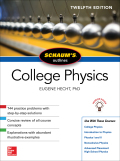
Concept explainers
A bar of dimensions
The elongation in a bar when clamped at one end and a stretching force of
Answer to Problem 38SP
Solution:
Explanation of Solution
Given data:
The dimensions of bar is
The mass of rod is
The frequency of fundamental tone of longitudinal vibration is
The force applied at the end of the bar is
Formula used:
Write the expression of density of rectangular bar.
Here,
Write the expression of speed of sound in a rectangular bar.
Here,
Write the expression of speed of longitudinal waves.
Here,
Write the expression of Young’s Modulus.
Here,
Explanation:
When the bar is clamped at its center and vibrates longitudinally, its ends are free. Therefore, the bar must have antinodes at its ends and a node at its center. The distance between node and antinode is
So, the expression for length of bar in terms of wavelength is,
Solve for
Substitute
The expression of speed of longitudinal waves is,
Substitute
The expression of density of rectangular bar is,
Substitute
The expression of speed of sound in a rectangular bar is,
Solve for
Substitute
Also, the expression of Young’s Modulus is,
Solve for
Substitute
Further, simplify the expression.
Conclusion:
The elongation in a bar when clamped at one end and a stretching force of
Want to see more full solutions like this?
Chapter 23 Solutions
College Physics
- What is the length of an closed-pipe resonator with a fundamental frequency of 400.0Hz? (Assume the speed of sound is 331m/s.) A. 41.38 cm B. 20.69 cm C. 165.1 cm D. 82.22 cmarrow_forwardAn open-pipe resonator has a fundamental frequency of 250.0 Hz. By how much would its length have to be changed to get a fundamental frequency of 300.0 Hz? (Assume the speed of sound is 331m/s.)arrow_forwardA steel wire in a piano has a length of 0.700 0 m and a mass of 4.300 × 10–3 kg. To what tension must this wire be stretched so that the fundamental vibration corresponds to middle C (fC = 261.6 Hz on the chromatic musical scale)?arrow_forward
- As shown , water is pumped into a tall, vertical cylinder at a volume flow rate R = 1.00 L/min. The radius of the cylinder is r = 5.00 cm, and at the open top of the cylinder a tuning fork is vibrating with a frequency f = 512 Hz. As the water rises, what time interval elapses between successive resonances?arrow_forwardAn aluminum rod, 1.00 m long, is held lightly in the middle. One end is struck head-on with a rubber mallet so that a longitudinal pulse—a sound wave—travels down the rod. The fundamental frequency of the longitudinal vibration is 3.20 kHz. At any given instant, in which direction do the two ends of the rod vibrate?arrow_forwardA tube, closed at one end and open at the other, vibrates at room temperature of 20 Celsius with a fundamental frequency of 125 Hz. Which of the following frequencies cannot be a higher harmonic of this system? a. 635Hz b. 750Hz c. 1375Hz d. 375Hz e. 875Hzarrow_forward
- 17. Harvey, a harpist, plucks a 0.600 m long string on his harp. The string has a first overtone of 1046.6 Hz. How fast does the vibration travel through the string? * a. 682 m/s b. 648 m/s c. 1256 m/s d. 432 m/s e. None of the abovearrow_forwardOne string of a certain musical instrument is 74.0 cm long and has a mass of 8.76 g. It is being played in a room where the speed of sound is 344 m/s. To what tension must you adjust the string so that, when vibrating in its second overtone, it produces sound of wavelength 0.760 m ? (Assume that the breaking stress of the wire is very large and isn’t exceeded.) What frequency sound does this string produce in its fundamental mode of vibration?arrow_forwardA wire with mass 60.0 g is stretched so that its ends are tied down at points 86.0 cm apart. The wire vibrates in its fundamental mode with frequency 65.0 Hz and with an amplitude of 0.400 cm at the antinodes. 1. Compute the tension in the wire.arrow_forward
- A steel wire with mass 25.4 g and length 1.30 m is strung on a bass so that the distance from the nut to the bridge is 1.10 m. (a) Compute the linear density of the string._______ kg/m(b) What velocity wave on the string will produce the desired fundamental frequency of the E1 string, 41.2 Hz? ________m/s(c) Calculate the tension required to obtain the proper frequency. ________N(d) Calculate the wavelength of the string's vibration. ________m(e) What is the wavelength of the sound produced in air? (Assume the speed of sound in air is 343 m/s.) _________marrow_forwardIf two adjacent frequencies of an organ pipe closed at one end are 550 Hz and 650 Hz, what is the length of the organ pipe? (vsound = 344 m/s) 1.72 m 0.86 m 3.44 m 2.58 marrow_forwardWhat is the frequency of the second harmonic of a steel piano wire stretched to a tension of 440N? The wire is 60cm long and has a mass of 5.6 grams. (a) 217Hz(b) 295Hz(c) 181Hz(d) 360Hz(e) 434Hzarrow_forward
 Principles of Physics: A Calculus-Based TextPhysicsISBN:9781133104261Author:Raymond A. Serway, John W. JewettPublisher:Cengage Learning
Principles of Physics: A Calculus-Based TextPhysicsISBN:9781133104261Author:Raymond A. Serway, John W. JewettPublisher:Cengage Learning Physics for Scientists and Engineers: Foundations...PhysicsISBN:9781133939146Author:Katz, Debora M.Publisher:Cengage Learning
Physics for Scientists and Engineers: Foundations...PhysicsISBN:9781133939146Author:Katz, Debora M.Publisher:Cengage Learning

